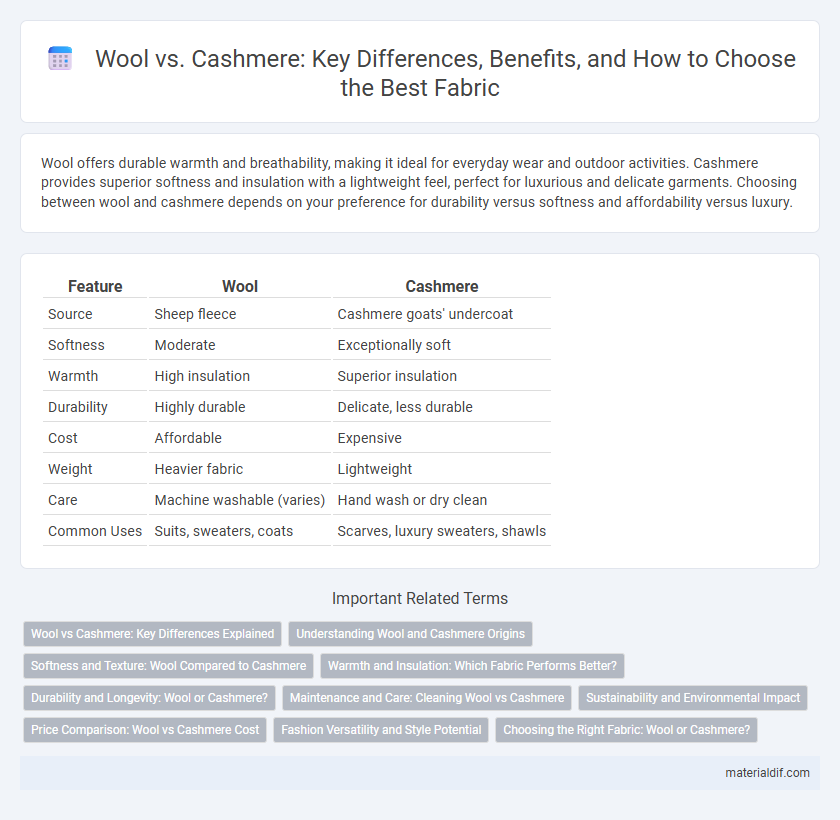Wool offers durable warmth and breathability, making it ideal for everyday wear and outdoor activities. Cashmere provides superior softness and insulation with a lightweight feel, perfect for luxurious and delicate garments. Choosing between wool and cashmere depends on your preference for durability versus softness and affordability versus luxury.
Table of Comparison
| Feature | Wool | Cashmere |
|---|---|---|
| Source | Sheep fleece | Cashmere goats' undercoat |
| Softness | Moderate | Exceptionally soft |
| Warmth | High insulation | Superior insulation |
| Durability | Highly durable | Delicate, less durable |
| Cost | Affordable | Expensive |
| Weight | Heavier fabric | Lightweight |
| Care | Machine washable (varies) | Hand wash or dry clean |
| Common Uses | Suits, sweaters, coats | Scarves, luxury sweaters, shawls |
Wool vs Cashmere: Key Differences Explained
Wool and cashmere both originate from animal fibers but differ significantly in texture, warmth, and price. Wool, sourced primarily from sheep, offers durability and excellent insulation, making it ideal for everyday wear and outdoor use. Cashmere, derived from the undercoat of cashmere goats, is finer, softer, and more luxurious, providing superior warmth and comfort but at a higher cost.
Understanding Wool and Cashmere Origins
Wool is sourced primarily from sheep breeds such as Merino and Rambouillet, valued for their thick, insulating fleece that provides durability and warmth. Cashmere comes from the soft undercoat of Cashmere goats, predominantly found in regions like Mongolia and Kashmir, known for its exceptional softness and lightweight warmth. Understanding these origins highlights the distinct textures and insulating properties that differentiate wool's robust resilience from cashmere's luxurious fineness.
Softness and Texture: Wool Compared to Cashmere
Cashmere fibers are finer and smoother than wool, resulting in a luxuriously soft texture that feels gentle against the skin. Wool, while also soft, has a coarser and denser texture that provides more durability and insulation. The softness of cashmere is often preferred for delicate garments, whereas wool is favored for its strength and warmth in outerwear.
Warmth and Insulation: Which Fabric Performs Better?
Cashmere offers superior insulation compared to wool, providing enhanced warmth due to its finer fibers that trap heat more effectively. While wool is also warm and breathable, cashmere's lightweight softness creates a cozy, insulating layer ideal for colder climates. Both fabrics excel in temperature regulation, but cashmere is generally preferred for maximum warmth without added bulk.
Durability and Longevity: Wool or Cashmere?
Wool fibers are generally more durable and resistant to wear than cashmere, making wool garments better suited for long-term use and frequent wear. Cashmere, derived from the soft undercoat of cashmere goats, offers exceptional softness but tends to be more delicate and prone to pilling, reducing its longevity compared to wool. Choosing wool ensures greater resilience and extended lifespan in outerwear and sweaters, while cashmere requires more careful maintenance to preserve its luxurious texture.
Maintenance and Care: Cleaning Wool vs Cashmere
Wool requires gentle hand washing or dry cleaning with mild detergents to maintain its natural oils and prevent shrinkage, while cashmere demands even more delicate care, often involving cold water hand washing and specialized cashmere shampoo to preserve its softness and avoid fiber damage. Both fabrics should be air-dried flat away from direct sunlight to retain shape and texture. Proper storage in breathable garment bags with lavender or cedar protects against moths and moisture, extending the life span of wool and cashmere garments.
Sustainability and Environmental Impact
Wool production generally has a lower environmental impact than cashmere, as sheep grazing can support biodiversity and improve soil health when managed sustainably. Cashmere goats, however, often cause overgrazing and desertification due to their high demand and less sustainable grazing practices. Sustainable certifications and responsible sourcing are crucial to minimizing ecological damage in both wool and cashmere industries.
Price Comparison: Wool vs Cashmere Cost
Cashmere typically commands a higher price than wool due to its rarity and superior softness. While wool is more affordable and widely available, cashmere's labor-intensive harvesting process and finer fibers contribute to its premium cost. Consumers often pay two to three times more for cashmere garments compared to similar wool products.
Fashion Versatility and Style Potential
Wool offers robust durability and warmth, making it a versatile choice for outerwear and structured garments in fashion collections. Cashmere's fine texture and luxurious softness elevate style potential, favored for high-end sweaters, scarves, and elegant layering pieces. Designers leverage wool for classic, everyday wear while cashmere is prized for sophisticated, statement looks in both casual and formal wardrobes.
Choosing the Right Fabric: Wool or Cashmere?
Wool offers excellent insulation, durability, and moisture-wicking properties, making it ideal for everyday wear and colder climates. Cashmere provides superior softness, lightweight warmth, and luxury appeal, perfect for delicate garments and mild to chilly weather. Selecting between wool and cashmere depends on the balance of comfort, intended use, and budget for your fabric needs.
Wool vs Cashmere Infographic

 materialdif.com
materialdif.com